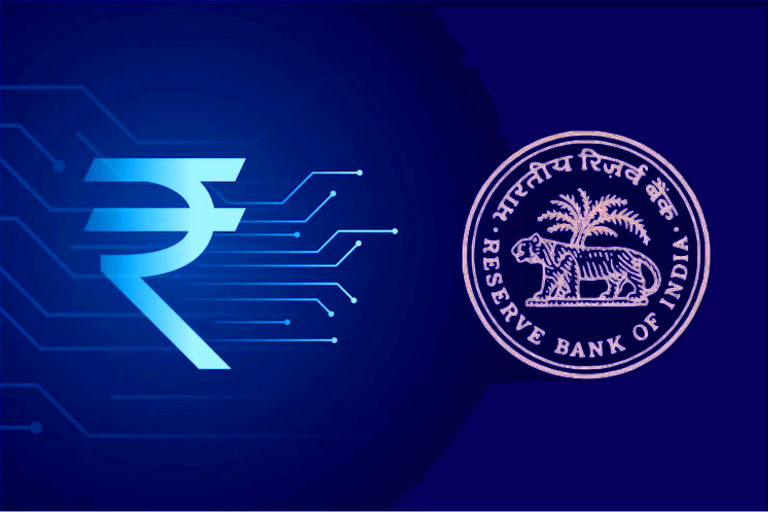RBI introduced e-rupee -Learn how it works?
RBI has introduced the Central Bank Digital Currency Or e rupee on October 7, 2022, which will work as the digital equivalent of a banknote and can be transferred electronically within a fraction of a second from one holder to another.
It is the same as cash that can be kept in a wallet on a mobile phone and also spent as cash is spent.
But what is e-rupee? What is the purpose of introducing this digital Currency?
Know that with this article.

What is e-rupee?
The Digital Rupee or eINR or E-Rupee which is symbolized as e₹ is a planned digital version of the Indian Rupee, which is issued by the Reserve Bank of India as a central bank digital currency (CBDC).
This Digital Rupee was initially proposed by the government of India in January 2017 and was planned to be launched in the 2022-23 financial year. The plan was initiated by RBI to incorporate distributed ledger into Digital Rupee.
This digital currency or e-rupee is uniquely identifiable and regulated by RBI like banknotes.
The liability of these digital currencies lies with RBI. Plans for e-rupee include both online and offline accessibility.
By launching CBDC, RBI has removed ₹4,984.80 crore security printing costs borne by the general public, businesses, banks, and RBI on physical currency.
Types of e rupee
The Central Bank Digital Currency is generally categorized into two types — general purpose or retail (CBDC-R) and wholesale (CBDC-W).
Retail CBDC is the digital currency that can be used by all including the private sector, non-financial consumers, and businesses while Wholesale CBDC is only designed for restricted access to selected financial institutions.
The retail CBDC is basically an electronic version of cash that is primarily meant for retail transactions. On the other hand, the wholesale CBDC is primarily designed for the settlement of interbank transfers and it is related to wholesale transactions.
According to RBI, the retail CBDC will provide safe access to money transactions for payment and settlement being it is a direct liability of the central bank. Whereas the Wholesale CBDC has the potential to transform the settlement of systems for financial transactions and make them more efficient and secure than retail CBDC.
There is individual potential for each of these. So there may be merit in introducing both CBDC-W and CBDC-R.

Features of e Rupee
Following are the features of e-rupee
1) CBDC Or e-rupee is a sovereign currency which issued by central banks in alignment with their monetary policy.
2) This digital currency appears as a liability on the balance sheet of the central bank
3) After a successful introduction, it can be accepted as a medium of payment, legal tender, and treated as a safe store of value by all citizens of the country, enterprises, and government agencies.
4) It is freely convertible money against commercial bank money and cash
5) This digital currency is a fungible legal tender for which currency holders need not have a bank account.
6) CBDC is believed to lower the cost of issuance of money, transactions, and printing of physical currency.
Why has the RBI introduced e-rupee?
According to RBI, the digital rupee will be treated as the rupee which is more attractive as a currency to users In comparison to cryptocurrencies.
In today’s scenario, Cryptocurrencies have been seen by investors as an effective alternative to fiat currencies which can progressively lose their value over time due to debasement by central banks.
Such a trend of Cryptocurrency threatens the sovereignty of the central bank. So they have been trying to come up with their own digital currencies in the form of a solution.
The RBI also believes that the e-rupee Or a digital currency will be much more easier and more economical to produce when compared to physical cash notes. Most importantly, transactions which are carried out using digital rupees, are more easily traceable by authorities in contrast to physical transactions,
As per the RBI regulator, CBDC is aimed to complement, rather than replace, the current forms of money and it is envisaged to provide an additional payment avenue to the end users, not to replace the existing payment systems.

RBI believes that this e-rupee system introduced by itself will bolster the digital economy of India, enhance financial inclusion, and make the monetary policy and payment systems more effective and efficient.
In order to point out the motivations for India to consider issuing this digital currency, RBI mentioned these reasons:
a) Reduction in cost associated with physical cash printing and management
b) To take a stand on active digitization and achieve a less cash economy.
c) Supports competition, efficiency, and innovation in the payments system.
d) To explore the use of e-rupee to improve cross-border transactions
e) Support financial inclusion in the country
f) Enhance the trust of a common man in the national currency rather than proliferation of crypto assets
Difference between e-rupee and UPI
E-rupee Or CBDC is often confused with UPI. But they differ from each other in a number of ways.
E-rupee, is basically the fiat currency in digital form, whereas UPI is a platform to facilitate banking transactions.
UPI transactions include the involvement of the bank. So, basically, when you use a UPI app, your bank account gets debited and money from your account gets transferred to the recipient’s bank.
Whereas in paper currency, you can draw the money from the bank, then keep it in your wallet and spend it at a shop.

How to buy RBI digital rupee?
RBI has primarily selected eight banks to take part in the phase-wise e-rupee pilot program. Initially, the State Bank of India, ICICI Bank, Yes Bank, and IDFC First Bank will comprise the first phase. Four other banks will join this pilot in the second phase soon.
These participating banks have already launched their digital rupee app to make these digital transactions more accessible.
This e-rupee is the digital version of your cash or paper money and not a cryptocurrency to be used. So, you can make transactions using any QR codes which are displayed at shops or malls to pay with an e-rupee.
How to use the digital rupee in India?
If you are planning to buy and make a transaction using the e-rupee, just have a look at the following points.
A closed user group (CUG) basically consists of participating both merchants and customers. This e-pilot cover selected locations in CUG.
The e-rupee Or digital currency will be issued in the same denominations as followed by any paper currency or coins. It is a digital token of the prevailing digital money which will be distributed to the citizen through banks as an intermediary.
Those banks will provide you with a digital wallet that you can use through your smartphones or laptops for any online transactions of e-rupee.
You can also opt for both person-to-person (P2P) and person-to-merchant (P2M) transactions by using various QR codes which are displayed at malls or shops.
Though digital medium, this e₹ comes with all features like any physical cash like safety, settlement finality, trust, etc.
You can also convert this digital rupee into various other forms of money such as bank deposits, but it will not earn any interest.
This e-rupee pilot conducts a real-time assessment of various retail use of digital rupees, distribution, and the stability of complete creation. Furthermore, the RBI is going to evaluate various uses and aspects of these digital tokens according to this assessment.
Conclusion
As you read this article far, you might have aware of e-rupee and why RBI has introduced this digital currency.
Then have your own e-rupee and take advantage of this great initiative of RBI.
*image source from Google
Check More News on World Economy:



